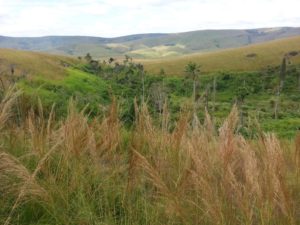
Listen to podcast | View slides
Speaker: Dr Maria Vorontsova, Research Leader, Integrated Monography, Royal Botanic Gardens, Kew
Anthropogenic destruction has long been blamed for 65% of Madagascar’s land area being covered by grassland and savanna, despite the flora of these regions never having been thoroughly investigated. Over the last six years, via new collections of Malagasy grasses and taxonomic work, we have found that an estimated 217 of Madagascar’s 541 grass species are endemic, a level of endemicity consistent with other subtropical islands. In total, Madagascar contains 70 endemic grass lineages that colonised Madagascar primarily from Africa, with a mean age of 3.5 million years; 50% of grass dispersals were C4 lineages pre-adapted to open canopy habitats. Today, the High Plateau, Madagascar’s largest area of intact grassland and savanna, is home to a diverse grass flora, where a grass checklist of the Itremo Protected Area alone found 20% of grass species are restricted to the High Plateau. Across these regions, grass community composition suggests Tapia woodlands, historically perceived as degraded forest, are a savanna and that the grass and tree functional traits of this ecosystems diverge strongly from gallery forests. Phylogenetic diversity within grassy ecosystems decreases with strong physical disturbance, such as grazing, indicating ecosystem dynamics typical of natural assemblages. Madagascar is home to an ancient and diverse grass flora, with local species assemblages functioning similarly to savanna ecosystems of Africa, indicating that pre-human Madagascar was home to, likely extensive, tropical grasslands and savannas. Our journey through this research program will identify and challenge six commonly held misconceptions about grasses and Madagascar.
Maria started this research journey in 2010 with the job title “Grass Taxonomist, The Herbarium, Royal Botanical Gardens, Kew”. She is currently working as “Research Leader, Integrated Monography, Comparative Plant and Fungal Biology, Royal Botanical Gardens, Kew”. Trained as a classical alpha taxonomist Maria’s primary work is herbarium based delimitation of plant species and their nomenclature. She also develops and maintains GrassBase, the world’s largest structured species description dataset covering the world’s 12,000 species of Poaceae. She battles against damaging misconceptions of grasses and of Madagascar, and integrates monographic work with paleoecology, phylogenomics, and population genetics.

